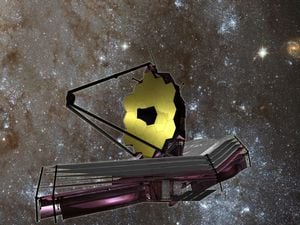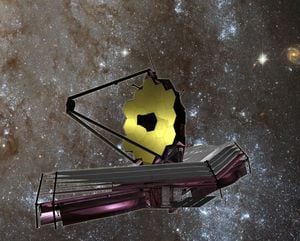Shropshire Sky At Night – December
Fourteen years late and billions of pounds (or dollars) over budget, December 22 (currently) is do or die time for the launch of the James Webb Space Telescope.

It is not just Hubble’s replacement but a whole new observing platform, transforming astronomy as we know it today. It is hoped to make discoveries that for so long we have thought out of reach.
One of the main goals for JWST is to look back to nearly the beginning of the Universe, just another way of saying ‘looking back in time.’ The cosmos has been expanding following the ‘Big Bang’, 13.8 billion years ago, where light travelling through space has been stretched along the way (red shifted). Visible light emitted by the first stars has been stretched to the extent that it is now only detectable only in the infrared part of the electromagnetic spectrum. I am sure it will be a big news item this month.

Talking about space vehicles, the International Space Station is visible for the first and last weeks of the month, orbiting at an average altitude of 248 miles (400 km) above Earth. It circles the globe every 90 minutes at a speed of about 17,500 mph (28,000 km/h). It is a really bright object to spot but you do need to know where to look, so a good star chart would be useful.
Peaking overnight of the 13th is the Geminids meteor shower. We may see up to 120 multicoloured meteors per hour, produced by debris left behind by an asteroid known as 3200 Phaethon.
If you miss the main even you might catch the Ursids meteor shower after midnight on the 21st. Being a minor meteor shower it only produces about five to 10 meteors per hour, which are produced by dust grains left behind by comet Tuttle.
Best viewing of any meteor shower is just after midnight from a dark location. Although meteors will radiate from the constellation in their name, they can appear anywhere in the sky.
For planet hunters Venus is a brilliant low-lying object at its best during the first half of the month as it heads for the horizon. However Jupiter more than makes up for it as the gas giant can easily be spotted at a higher altitude.
For Saturn lovers it is best sought for early in the month in the constellation of Capricornus before it also heads for the horizon. Ceres, the largest asteroid, can be spotted in the evening sky among the stars of Taurus. Makemake and Haumea are both well up in the east by the end of the night, but you will need your binoculars or small telescope.
The December solstice occurs at 15:50 GMT on the 21st. The South Pole of the Earth will be tilted toward the Sun, which will have reached its southernmost position in the sky and will be directly over the Tropic of Capricorn at 23.44 degrees south latitude. This is the first day of winter – so start to wrap up warm.
Steve Szwajkun FRAS, Shropshire Astronomical Society





